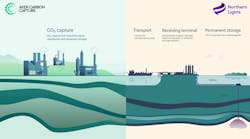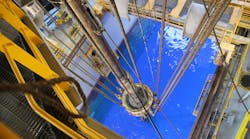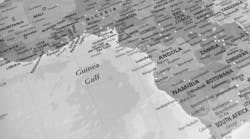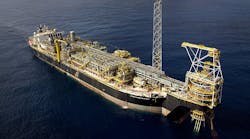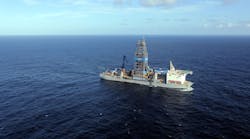Offshore staff
STAVANGER, Norway — A drilling campaign has started on the Northern Lights partnership’s CO2 storage license EL001 in the southern Norwegian North Sea, 100 km west of Bergen, according to an Aug. 5 Northern Lights report.
Initially the Transocean Enabler semisubmersible will drill a CO2 injector well as a sidetrack to the exploration well drilled in 2020. It will then drill a new contingent well to be used for injection should the primary well be out of operation for maintenance or other reasons.
This contingency will provide backup injection capacity along with stable and uninterrupted injection of CO2 for Northern Lights’ clients once operations start in mid-2024.
The wells will have capacity for injecting 1.5 MM metric tons per year of CO2 into the Johansen Formation, 2,700 m below sea level. The storage complex contains sandstone with good flow properties and the overlying Drake Formation shale is said to provide a competent seal.
That in turn should ensure the CO2 cannot migrate out of the storage complex and that the CO2 injected into the reservoir will therefore be permanently stored.
Equinor is managing the current drilling operations as operator of the Northern Lights joint venture (JV). The partners will share well data once the drilling campaign has finished, helping to stimulate other future CO2 storage projects.
In addition, the JV has announced a memorandum of understanding with Eramet Norway to collaborate on a project to capture and store 70% of the CO2 emissions from the manganese smelter in Sauda, Norway.
The project will use carbon capture and storage (CCS) to decarbonize smelting operations, with the carbon capture pilot facility testing the suitability of Air Liquide’s Cryocap technology for the pre-concentration of ferromanganese flue gas from 2024.
A full-scale carbon capture facility should follow in 2028, reaching its maximum capacity (260,000 metric tons per year of CO2 in 2030, using Northern Lights’ infrastructure for transport and permanent storage beneath the North Sea.
In Phase 1, due to be completed in mid-2024, Northern Lights will provide CO2 storage capacity of 1.5 MM metric tons per year, rising to more than 5 MM metric tons per year in Phase 2, which could be operational by 2026.
Northern Lights is owned equally by Equinor, Shell and TotalEnergies.
08.18.2022



